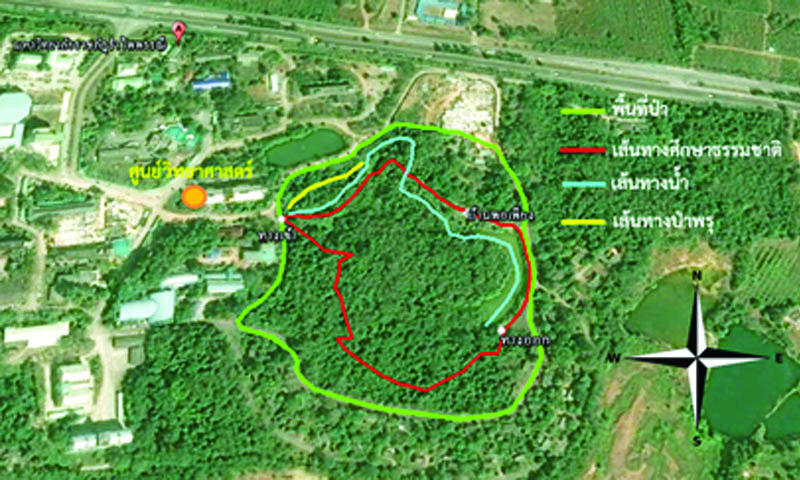การสำรวจไลเคนบริเวณป่าพรุในพื้นที่ปกปักพันธุกรรมพืชฯ มหาวิทยาลัยราชภัฏรำไพพรรณี
Main Article Content
บทคัดย่อ
การสำรวจไลเคนบริเวณป่าพรุในพื้นที่ปกปักพันธุกรรมพืชฯ ของมหาวิทยาลัยราชภัฏรำไพพรรณีในช่วงเดือนมกราคม - ตุลาคม พ.ศ. 2561 ทำการเก็บตัวอย่างไลเคนจากเปลือกต้นไม้ทุกต้นตลอดเส้นทางเดินสำรวจป่าพรุรวมระยะทาง 220 เมตร ร่วมกับการเก็บข้อมูลสภาพแวดล้อม พบตัวอย่างไลเคนทั้งหมด 53 ตัวอย่าง ถูกนำมาวิเคราะห์ทางสัณฐานวิทยา อนุกรมวิธาน และทดสอบองค์ประกอบทางเคมีโดยวิธีทดสอบสีในห้องปฏิบัติการ พบว่าไลเคนส่วนใหญ่มีรูปแบบการเจริญเติบโตเป็นแบบครัสโตสไลเคนคิดเป็นร้อยละ 96.23 มีเพียง 2 ตัวอย่าง ที่มีรูปแบบการเจริญเติบโตแบบสแควมูโลส (Squamulose) คิดเป็นร้อยละ 3.77 โดยไลเคนที่พบสามารถจำแนกได้ 10 วงศ์ 16 สกุล 27 ชนิด ซึ่งวงศ์ที่มีความหลากหลายมากที่สุด 3 อันดับแรก จำแนกตามจำนวนสกุลและชนิดที่ระบุได ้ ได้แก่ วงศ์ Graphidaceae (7 สกุล 11 ชนิด และระบุชนิดไม่ได้ 1 ชนิด รวม 26 ตัวอย่าง) วงศ์ Pyrenulaceae (1 สกุล 3 ชนิด และระบุชนิดไม่ได้ 1 ชนิด รวม 8 ตัวอย่าง) และวงศ์ Malmideaceae (1 สกุล 1 ชนิด และระบุชนิดไม่ได้ 1 ชนิด รวม 6 ตัวอย่าง) คิดเป็นร้อยละ 49.06 15.09 และ 11.32 ตามลำดับ ซึ่งไลเคนทั้ง 3 วงศ์นี้มักพบเจริญในสภาพแวดล้อมทั่วไปที่มีความชื้นและมีร่มเงา
Article Details
References
[2] Ahmadjian, V. and Hale, M. E. (1993). The Lichens. Academic Press. New York
[3] Gilbert, O. (2000). Lichens. London. HarperCollins
[4] Somnuek, C., Poengsungnoen, V., KhamChatra, N., and Nongnutch, K. (2017). Lichens on Nature Trail in Plant Genetic Conservation Project, Rambhai Barni Rajabhat University, Chanthaburi Province. KKU Science Journal. Vol. 45, No. 1, pp. 193-199 (in Thai)
[5] Upreti, D. K. (1998). Diversity of Lichen in India. In: Perspective in Environment (Eds.: S. K. Aggarwal; J. P. Kaushik; K. K. Kaul and A. K. Jain), New Delhi, A.P.H. Publishing Corporation. pp. 71-79
[6] Tiwari, S. C. and Prajapati, A. (2015). Lichen as Indicator of Forest Health Status in Achanakmar Amarkantak Biosphere Reserve. International Journal of Research Studies in Biosciences (IJRSB). Vol. 3, Issue 4, (April 2015). pp. 70-79
[7] Sodamuk, M. and Mongkolsuk, P. (2014). Lichen in Mangrave Forest at Koh Rua Sri, Trat Province in the Eastern, Thailand. In Proceeding of the 40th Congress on Science and Technology of Thailand (STT40). pp. 826-830
[8] Boonpragob, K. and Buaruang, K. (2007). Lichen of Samaesan Island from hilltop to the Sea. Bangkok: Ramkhamhaeng University Press. (in Thai)
[9] Saipunkaew, W. (2008). Lichen and Environmental Quality Inspection. Workshop Document. Department of Biology, Faculty of Science, Changmai University. Changmai. (in Thai)
[10] Zedda, L. (2009). Report on Lichen Sensitivity to Air Pollution with Special Reference to Sulphur Dioxide (SO2). Access (5 February 2019). Available (https://www.researchgate.net/publication/242270865)
[11] Lücking, R., Plata, E. R., Parnmen, S., Kalb, K., Mangold, A., and Lumbsch, H. T. (2011). Tropical Lichen Guides: Graphidaceae Lichens of the World. Access (11 February 2019). Available (https://fieldguides.fieldmuseum.org/ guides/guide/355)
[12] Lange, O. T., Green, T. G. A., and Heber, U. (2001). Hydration-Dependent Photosynthetic Production of Lichen: What Do Laboratory Studies Tell us About Field Performance?. Journal of Experimental Botany. Vol. 52, Issue 363, pp. 2033-2042. DOI: 10.1093/jexbot/52.363.2033
[13] Phokaeo, S., Polyiam, W., Buaruang, K., Vongshewarat, K., and Boonpragob, K. (2013). Preliminary Study on the Pyrenolichens from the Islands of Thailand. Thai Journal of Botany. Vol. 5, (Special Issue). pp. 62-73 (in Thai)
[14] Sriprang, V. and Mongkolsuk, P. (2010). Discolichens at Phu Luang Wildlife Sanctuary, Loei province. Thai Journal of Botany. Vol. 2, (Special Issue). pp. 47-53 (in Thai)
[15] Saipunkaew, W., Wolseley, P., and Chimonides, P. J. (2005). Epiphytic Lichens as Indicators of Environmental Health in the Vicinity of Chiang Mai City, Thailand. Lichenologist. Vol. 37, No. 4, pp. 345-365

